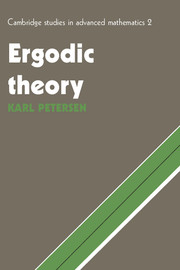
-
Select format
-
- Publisher:
- Cambridge University Press
- Publication date:
- June 2012
- May 1983
- ISBN:
- 9780511608728
- 9780521389976
- Dimensions:
- Weight & Pages:
- Dimensions:
- (228 x 152 mm)
- Weight & Pages:
- 0.51kg, 344 Pages
You may already have access via personal or institutional login
Book description
The study of dynamical systems forms a vast and rapidly developing field even when one considers only activity whose methods derive mainly from measure theory and functional analysis. Karl Petersen has written a book which presents the fundamentals of the ergodic theory of point transformations and then several advanced topics which are currently undergoing intense research. By selecting one or more of these topics to focus on, the reader can quickly approach the specialized literature and indeed the frontier of the area of interest. Each of the four basic aspects of ergodic theory - examples, convergence theorems, recurrence properties, and entropy - receives first a basic and then a more advanced, particularized treatment. At the introductory level, the book provides clear and complete discussions of the standard examples, the mean and pointwise ergodic theorems, recurrence, ergodicity, weak mixing, strong mixing, and the fundamentals of entropy. Among the advanced topics are a thorough treatment of maximal functions and their usefulness in ergodic theory, analysis, and probability, an introduction to almost-periodic functions and topological dynamics, a proof of the Jewett-Krieger Theorem, an introduction to multiple recurrence and the Szemeredi-Furstenberg Theorem, and the Keane-Smorodinsky proof of Ornstein's Isomorphism Theorem for Bernoulli shifts. The author's easily-readable style combined with the profusion of exercises and references, summaries, historical remarks, and heuristic discussions make this book useful either as a text for graduate students or self-study, or as a reference work for the initiated.
Reviews
‘What the contents list does not prepare you for is the very high standard of exposition. The scholarship involved in this work will be appreciated by workers in the field and by generations of research students. I personally think this is an excellent book. It is a book which can be explored at leisure and has a place in the library of anyone with a more than passing interest in ergodic theory.’
Source: Bulletin of the London Mathematical Society
‘ … an excellent introduction to several areas which are of interest both from the point of view of the mathematical scholar and from that of the research mathematician.’
Source: American Scientist
Contents
Metrics
Altmetric attention score
Full text views
Full text views help Loading metrics...
Loading metrics...
* Views captured on Cambridge Core between #date#. This data will be updated every 24 hours.
Usage data cannot currently be displayed.
Accessibility standard: Unknown
Why this information is here
This section outlines the accessibility features of this content - including support for screen readers, full keyboard navigation and high-contrast display options. This may not be relevant for you.
Accessibility Information
Accessibility compliance for the PDF of this book is currently unknown and may be updated in the future.


